At the end of my last article about how Tesumo, the natural Teak-surrogate, has been invented, I promised to take you into the holy halls of the Lürssen shipyard in Bremen. If you haven´t read this piece, do it, because it´s not just only interesting, but also necessary information you need to get the full scope of what these guys are doing here – not less than inventing a sustainable future for natural high-grade yacht decks substituting Teak. That said – let´s go! Bremen, a sunny summer´s day: perfect for a shooting of this impressive premise. It could have been. But instead, we jump directly aboard the super-yacht.
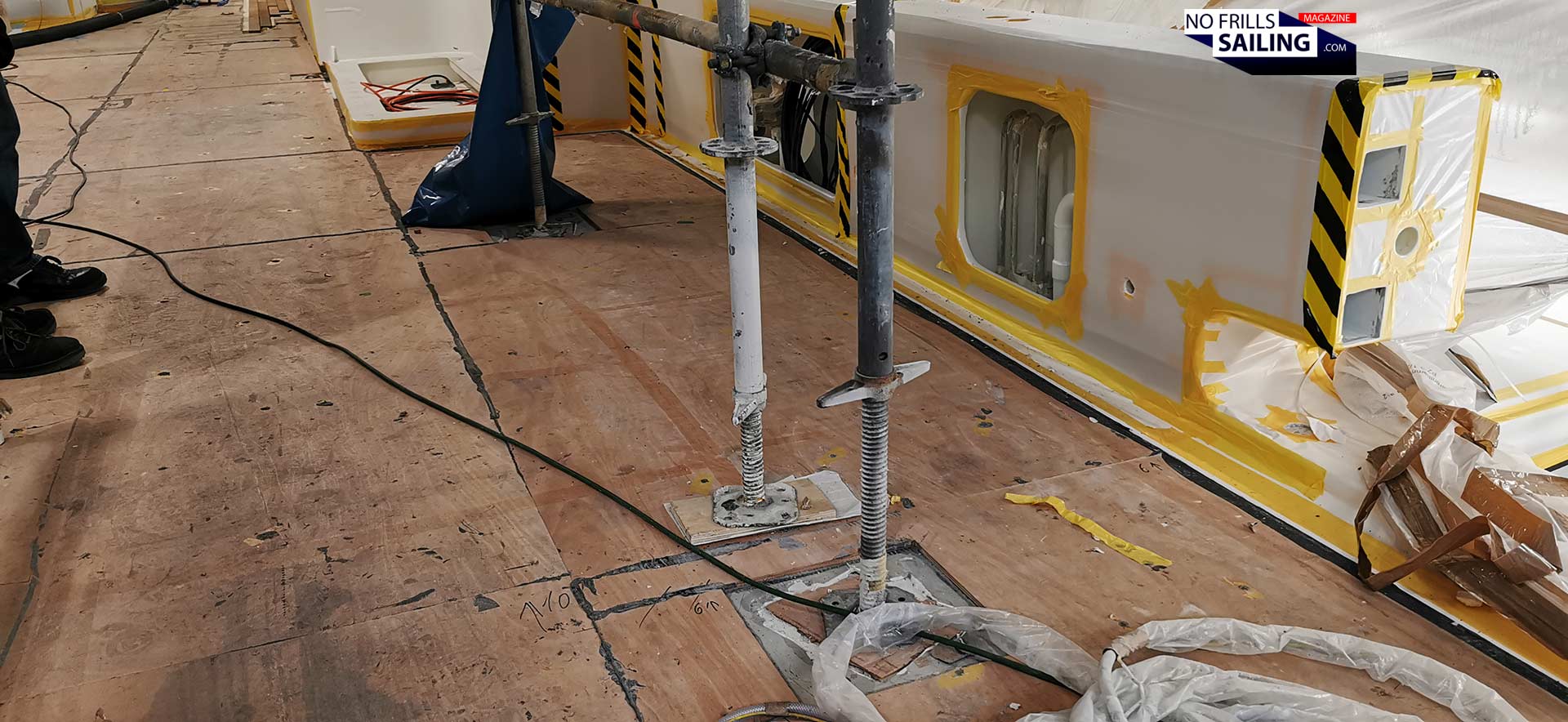
Super-yacht, mega-yacht: That´s a little “problem” here: With Lürssen being the world´s biggest and most ambitious shipbuilder for the absolute high-end yachts on the planet, taking pictures is strictly forbidden. Only a very limited selection of pictures not showing any general stuff nor specifics of the projects, the shipyard´s halls, employees and … virtually nothing is allowed. These pictures had to be taken by Lürssen employees who exactly know what is confidential and what detail may be published. Even then, their compendium had been screened and that´s only when I came in. So. Unfortunately, no pictures of the ship. But that doesn´t mean it is not worth reading further!
Normally strictly forbidden: A look onto Lürssen´s latest mega yacht
Of course I can understand these strict security measurements: Keeping out competition, safeguarding their customer´s identities and property and also keeping the secrets of the defense projects, Lürssen is also realizing for various navies of the world, is of utmost importance. In this, you just have to believe me that the walk into the shipbuilding hall with the yacht you are about to discover with me, was absolutely breathtaking! The sheer size of this super-yacht (or is it a mega-yacht?) is absolutely staggering! Although she had been wrapped in plastic, surrounded closely by scaffolding, I was stunned and speechless.
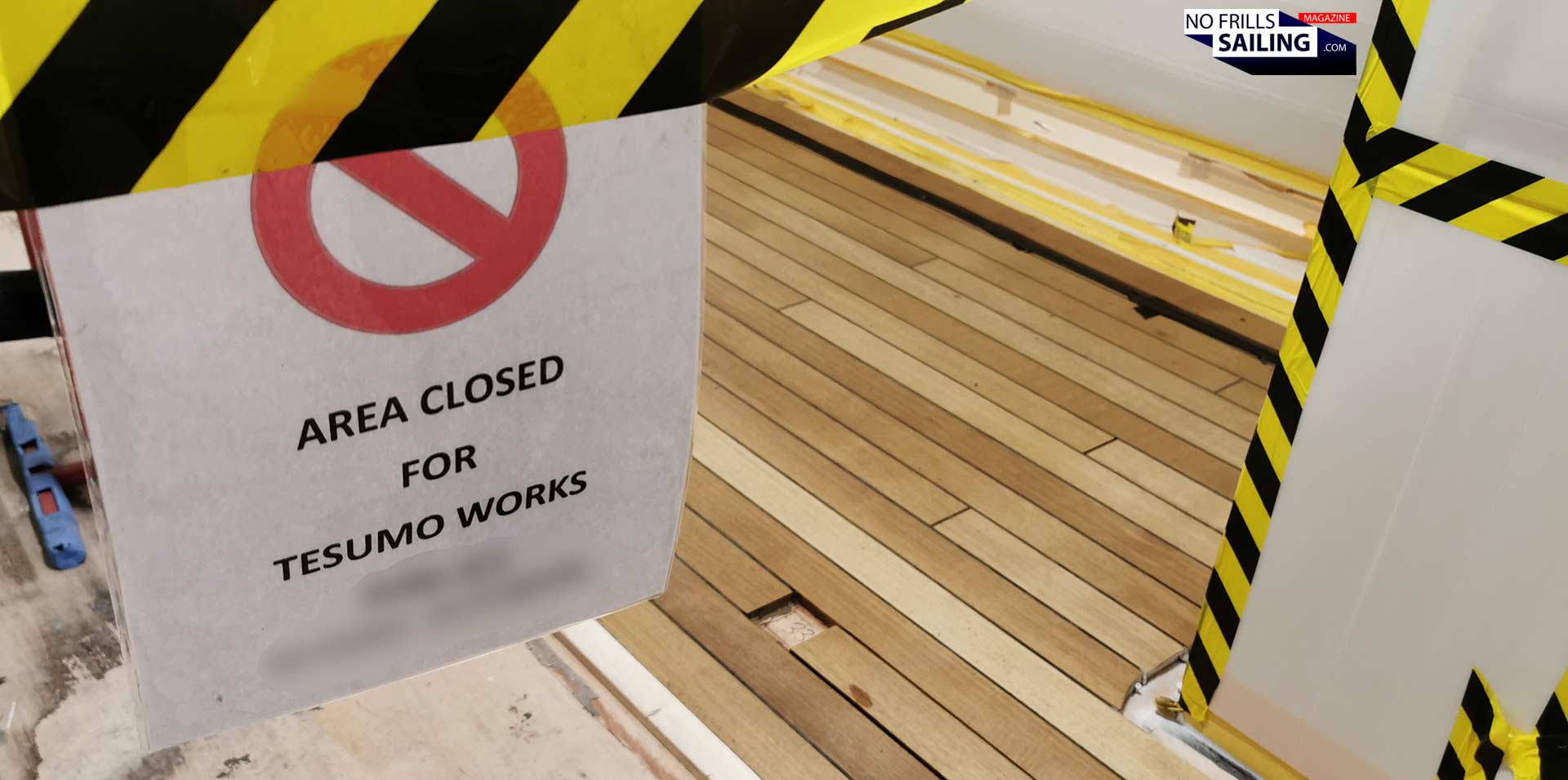
After passing the security check at the entrance, I´ve had to take a high staircase that had been mounted outside of the massive, but sleek and beautiful hull. That´s several stories until we reached one of the decks. Let´s be reminded that my intention with this article was to show how Tesumo is installed onto a yacht´s deck. Is it the same as Teak? Glued? Screwed? How is it done? So, following Frank Lüssen one of the “fathers” of Tesumo, working for Lürssen’s Outfitting Design department, and Arne Petersen, CEO of Tesumo, we were about to see how this new natural Teak-surrogate is processed and treated to become a beautiful yacht deck.
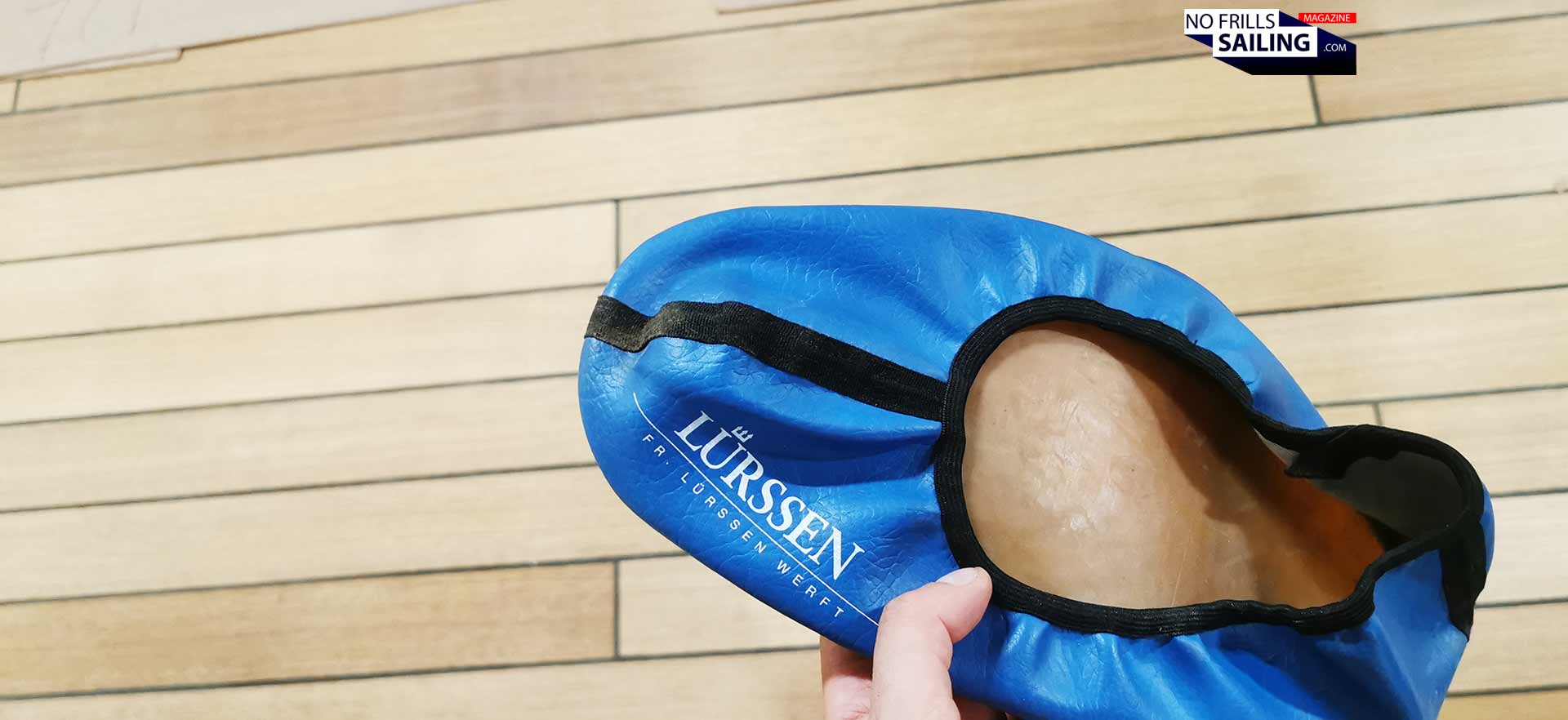
We will be starting at the raw, loose planks arriving from the Tesumo-plant. By the way, you should also check out the my very first article about how Tesumo is made. I am roaming the production facility, just vis-à-vis the Lürssen shipyard over the River Weser, and document in detail how raw Limba is turned into the deck material used by LürssenLürssen. After passing a deck where Tesumo had already been installed (and which is now covered under a layer of protective plywood), we finally reach an area where the joiners and deck specialists are indeed working.
Could you tell? Teak or … Tesumo?
One precondition for me to getting granted access to Lürssen (besides sending my ID, for a background check?) was that I should bring steel-toed safety/working boots. Which I did. I was given a protective helmet in white. Upon walking on the precious brand new deck, we had to put on nice leather slippers over the big boots. Then I set my first foot onto the deck of a real Lürssen mega-yacht.
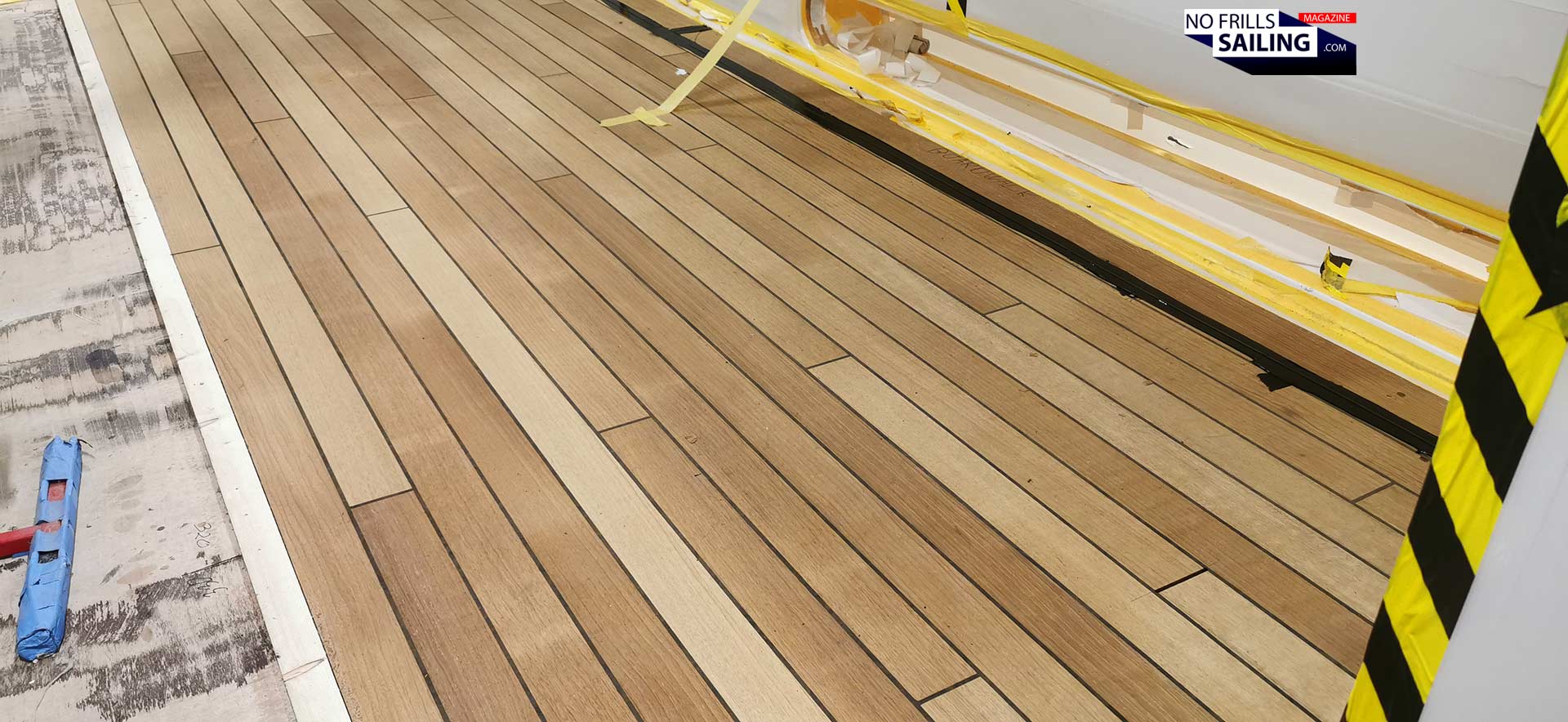
The guys warned me: Taking pictures of a fresh deck is a tricky thing. Just like photographing waves on the ocean, where you never really catch the real height and impressive masses moving by. It´s quite a similar thing with boat decks: It seems that the cameras are over-tuning the contrasts between the planks, making for a “zebra-look”. So I switched off HDR-effect, but still, in the pictures there is a lot of color-difference between the planks. In reality, these variations are much more subtle.

The area we visited first had just been approved and is considered almost finished. There will be last touches of work, then the protective layer of plywood will also be installed and not taken away just shortly before launch. As I walk over the deck, the feel was awesome. Totally different from an ordinary boat, which I guess has something to do with the boat´s material (steel) and the thickness of everything. In case of the planks, up to 33 millimeters! Checking the surface quality with my fingers, it was perfectly smooth. You could feel no grain, no irregularities and of course not a single splinter or defect. Just perfect. I mean, look at the pictures: It almost looks like a computer rendering!
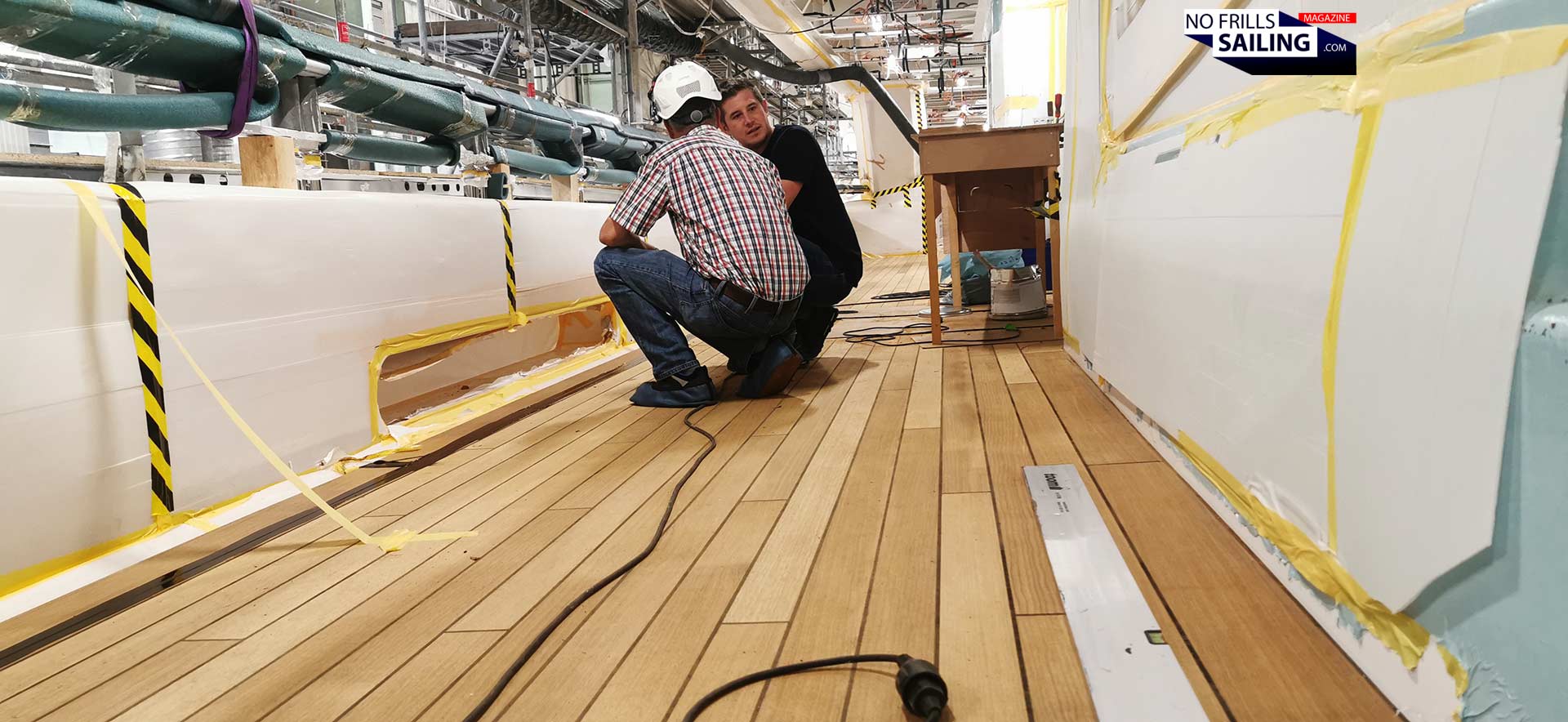
We are joined by the production manager for this yacht´s deck. Frank seizes the opportunity to use this walkaround with a quality check and some tech-talk. Best for me: I now can ask my questions to the theorist, engineer and the practitioner, project manager at the same time. The minimum standard required here at Lürssen is not even close to what I´ve seen so far in any shipyard I´ve visited up to now. I mean, I knew that a superyacht-builder must be something different (means: better) compared to my “usual” cruising sailboat-maker, but I would never ever have guessed that the difference would be that much. Really.
How the pros are installing a wooden yacht deck
Here at Lürssen in Bremen, more than a thousand craftsmen are directly employed by the shipyard. Apart from their own staff, an army of sub-contractors is whirling around. The deck and woodworks, as they explain to me, for this mega-yacht project has also been awarded to an external. It´s a company that specializes in large ship deck installation: Joiners and shipwrights who do nothing else than making, maintaining or repairing wooden decks of large yachts and ships. So let´s look how it´s done …
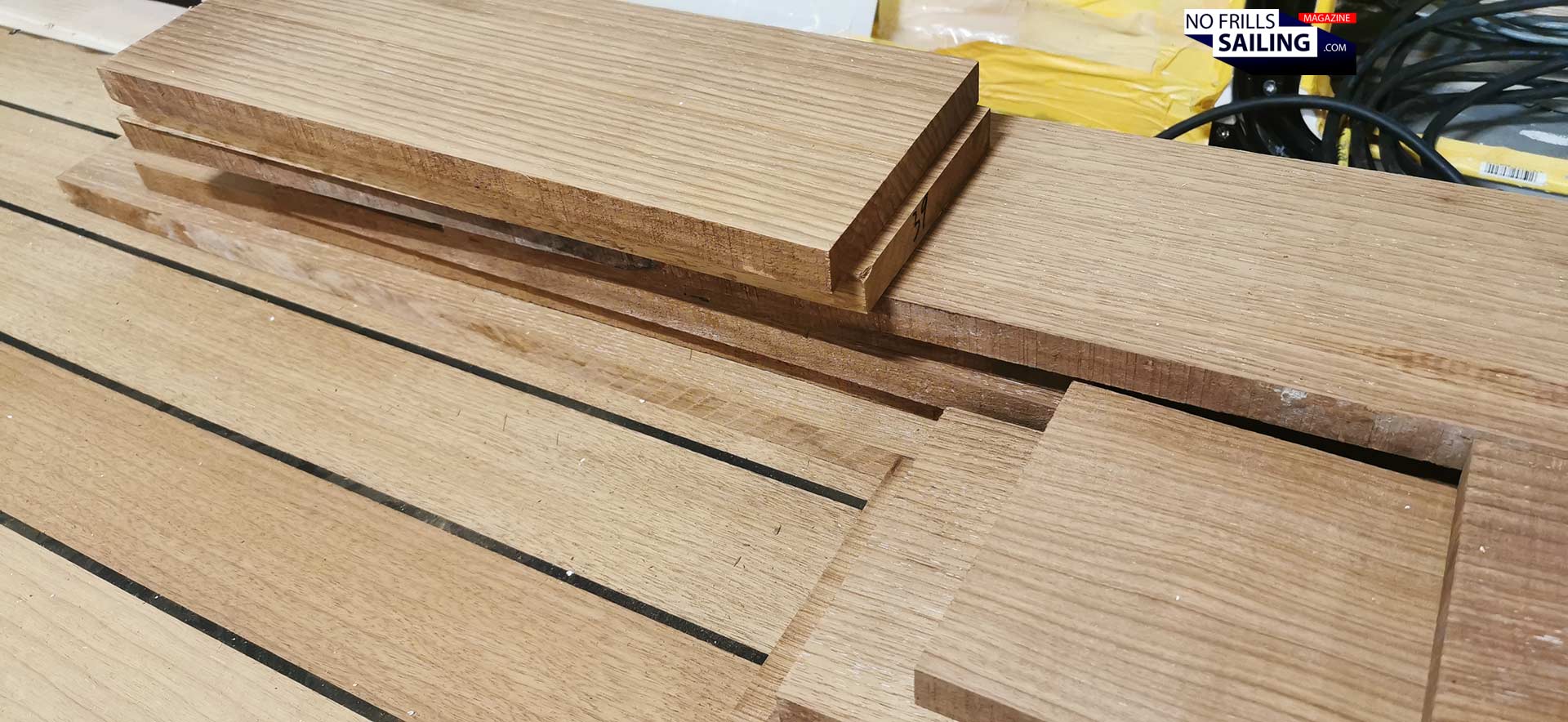
First of all, the Tesumo planks are brought onto the boat to a workstation near the area that is about to be covered with it. The individual planks are already pre-processed in the shipyard´s joinery (which we will visit later in this article). The trained eyes of the joiners will select the planks according to their color grading and grain structure. The idea is to have a nice looking, homogenic surface impression on the one hand, but also a “shiplike” attractive look.

As this is barely a yacht, more a real ship, it´s made from steel of course. The guys tell me that Tesumo, just like Teak wouldn´t as well, is not applied directly to the bare steel deck of the ship. The first layer is always a tie-layer which also has some insulating properties to it. For Tesumo, that´s either cork or plywood. As you can see on the picture below, Lürssen´s deck pros went for a plywood-layer. This is bonded with a special marine glue directly onto the steel deck. Now the Tesumo planks – one by one – can be fitted.

And it is really done as they have done it for centuries in the old days: One plank after another. Utilizing another special marine glue and precision cut spacers, the planks are put in a special pattern onto the plywood-layer. The guys double- and triple-check the seams, the distance from one to another and really take their time to achieve a perfect outcome.
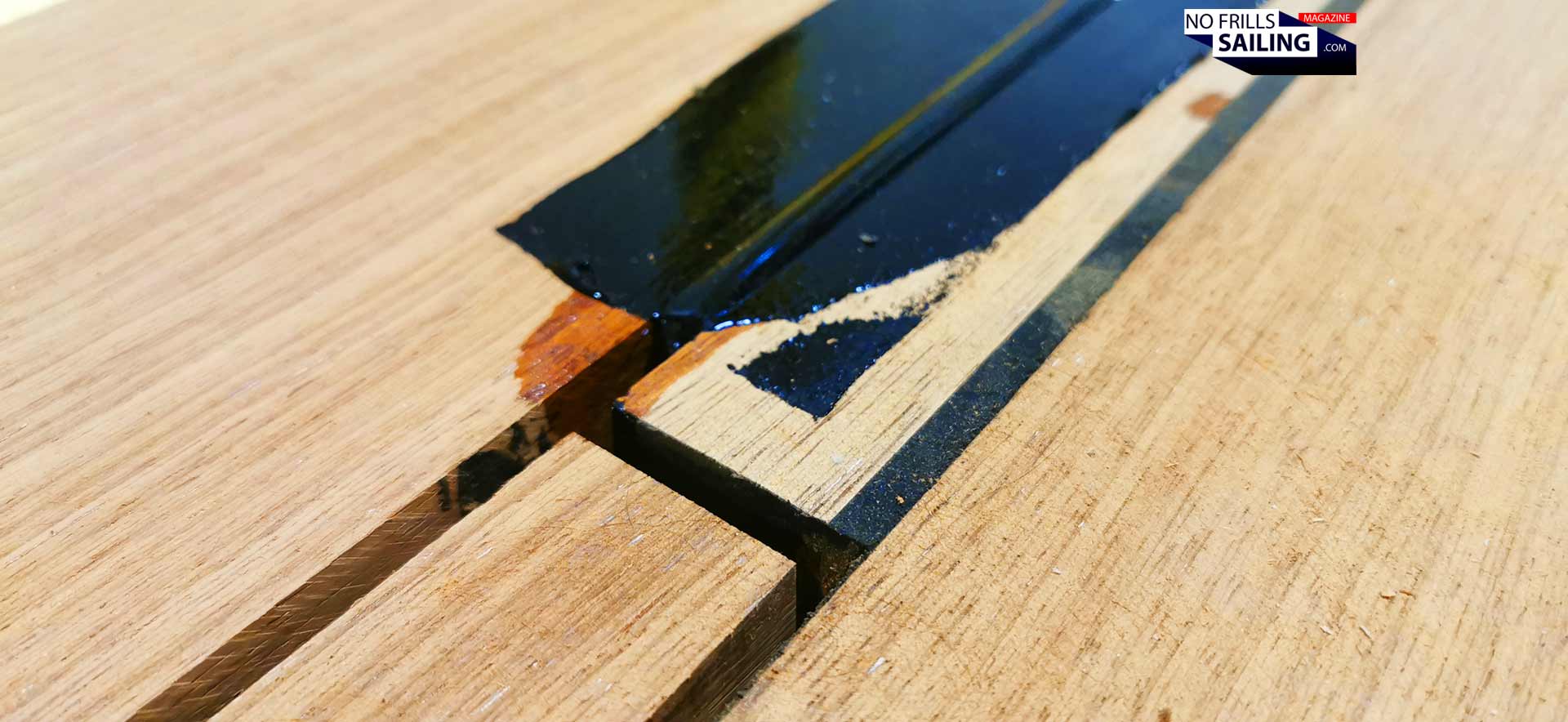
It´s a stark contrast to what I´ve seen in many production boat shipyards. For our ordinary cruising sailboat, wooden decks (as well as decks made from PVC-surrogates are delivered to the yard by contractors as pre-fabricated large panels. Those are usually vacuum-glued (and sometimes also partially screwed) onto the GRP-decks. Sheet-mounting is a time-saving way for series production boat, but is neither practical nor acceptable for Lürssen. Each deck, each area, each piece is the product of a unique one-off manufacture.
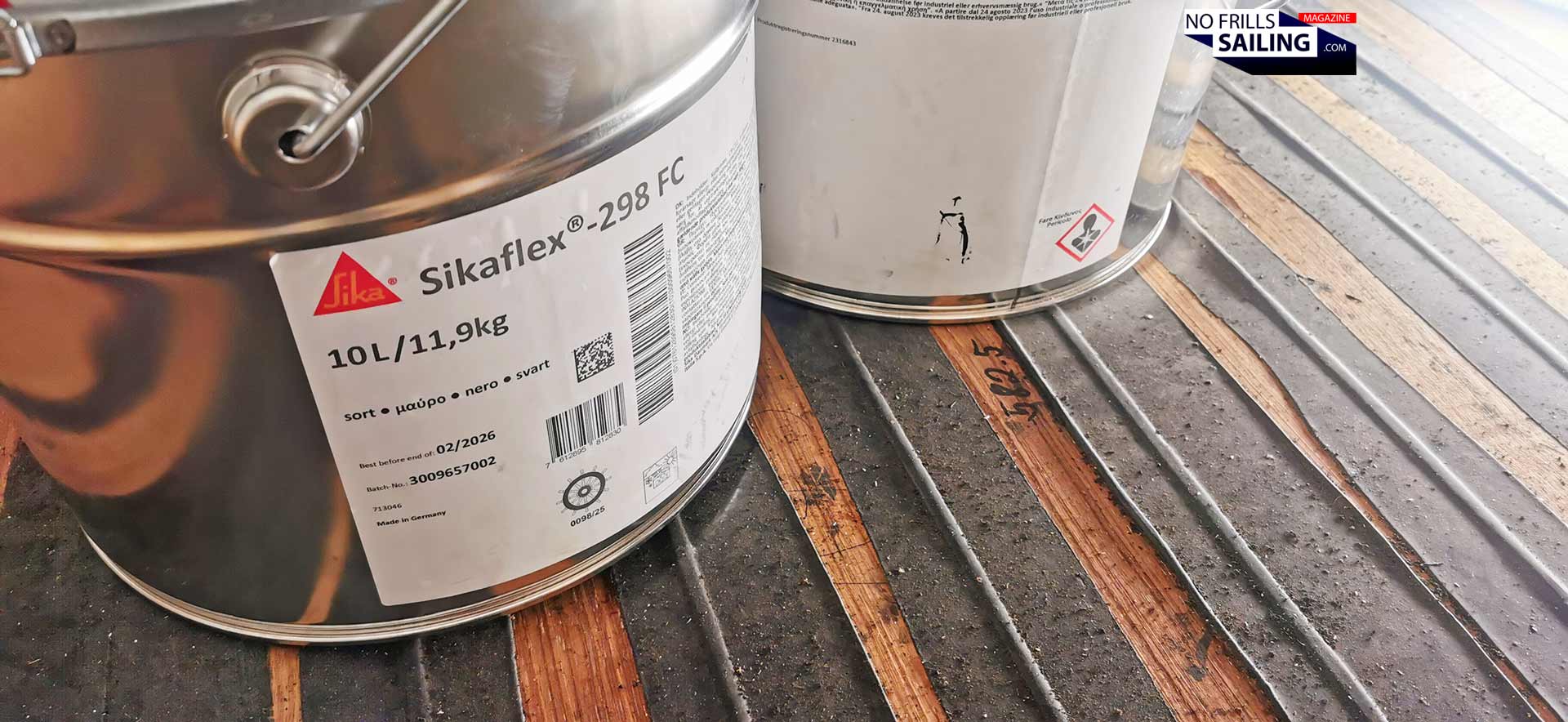
The next working step is the caulking. As with any ship´s deck, a Lürssen customer can choose from several colors for the caulking, although black is preferred and suggestd. For this Lürssen mega-yacht, the owners went for a nice sleek deep black, which I like very much. So lets look at how it is done here …
Caulking and coamings – the right way
We enter another deck situated more to the bow near the large helipad of this yacht. Here the Tesumo deck installation is a step further in the process. It has already been laid completely as has the raw caulking been done. I am surprised to see an old acquaintance: Sikaflex! I don´t know what I was expecting, but I had to smile for myself that these high-grade professionals are also working with our beloved Sika-products.

A fact that in itself is a confirmation of the quality and testament to the quality of Sika. Again, Lürssen only approves Tier A-quality. So … Anyway, I find myself standing on the entrance to the bow´s helicopter landing spot. Tesumo is already fitted, a first thick layer of caulking applied in between the deck planks. Large sanding machines – not unlike the ones we utilize at home to plane our timber floors – are used here. But most of the deck isn´t sanded. One of the workers explains to me that they will keep the floor covered in Sika that way as long as possible: Dozens of workers are walking and working here every day, this way it´s still protected.
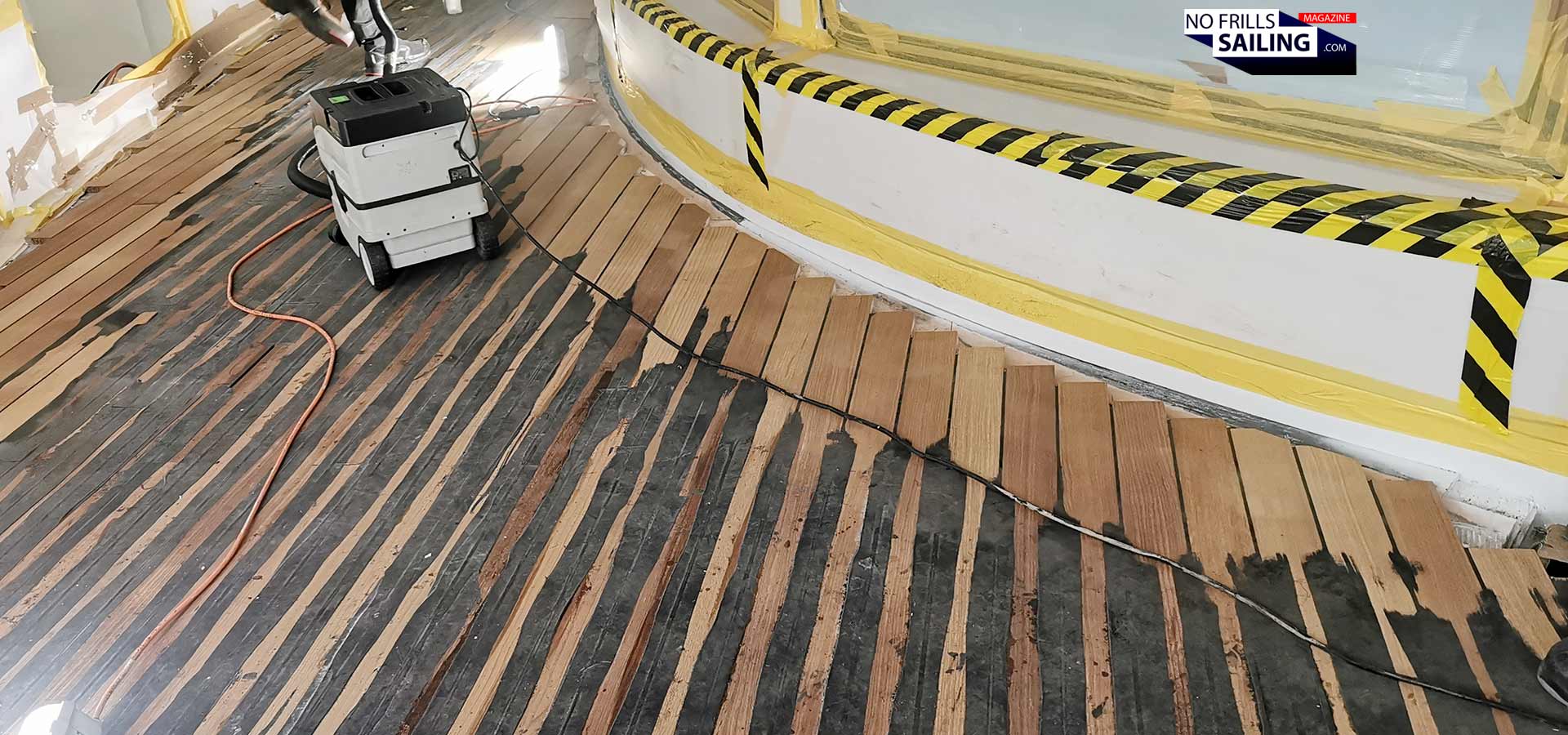
On the sides the guys have already sanded the deck, taking away the overlaying Sika caulking. This is because works to make the coamings are about to start soon here. After all installations have been done, it is now time to add to the deck what later will become pure eye-candy. It´s a quality sign and pride of any ship´s. The efforts that go into the coamings, be it the surrounding “outline” of a deck, the curves around bent superstructures, the coaming around a head or hatch, these efforts define the class and beauty of a yacht´s deck.

So, the first step is to cut the overlapping material of the square planks into the rounded shape of the structure the coaming will later follow. This is why on the edges of this part of the deck the caulking has already been sanded off, laying bare the deck planks. Again, the transformation of such a rough – and admittedly not very beautiful – area into the fine, almost artistic beauty of a proper coaming is something only the best craftsman and shipwrights. And I am about to meet one.
This. Is. Craftsmanship!
I ask Frank if I could see an example for a half-finished coaming. We find a spot: A side-opening in the rigid deckside barrier, maybe a seaside entrance. This is only a small recess, not deeper than 30 centimeters at best, but the level of meticulous craftsmanship, measurement, geometric construction and care just to make the coaming for this part is pure eye-candy.
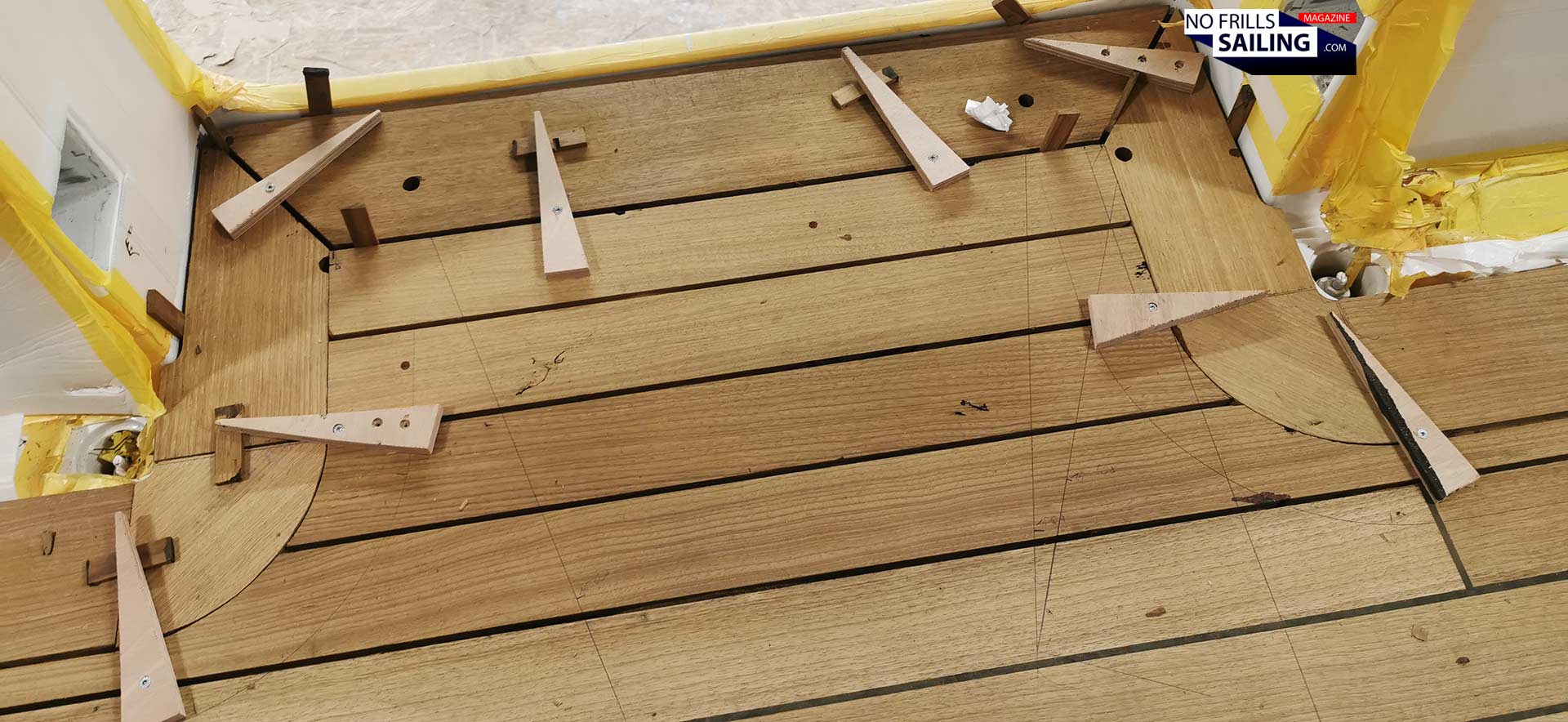
It´s not only the wider outer plank, but also the curvature of the planks, the care for angles, curves and grain, that is surprising to me. The level of detail! I can imagine how they work here because the pencil drawn reference lines are still visible. These give an impression of the calculations the joiner had to respect in order to build this part. It almost reminds me a little of Leonardo DaVinci´s famous “Vitruvian Man” … beautiful!
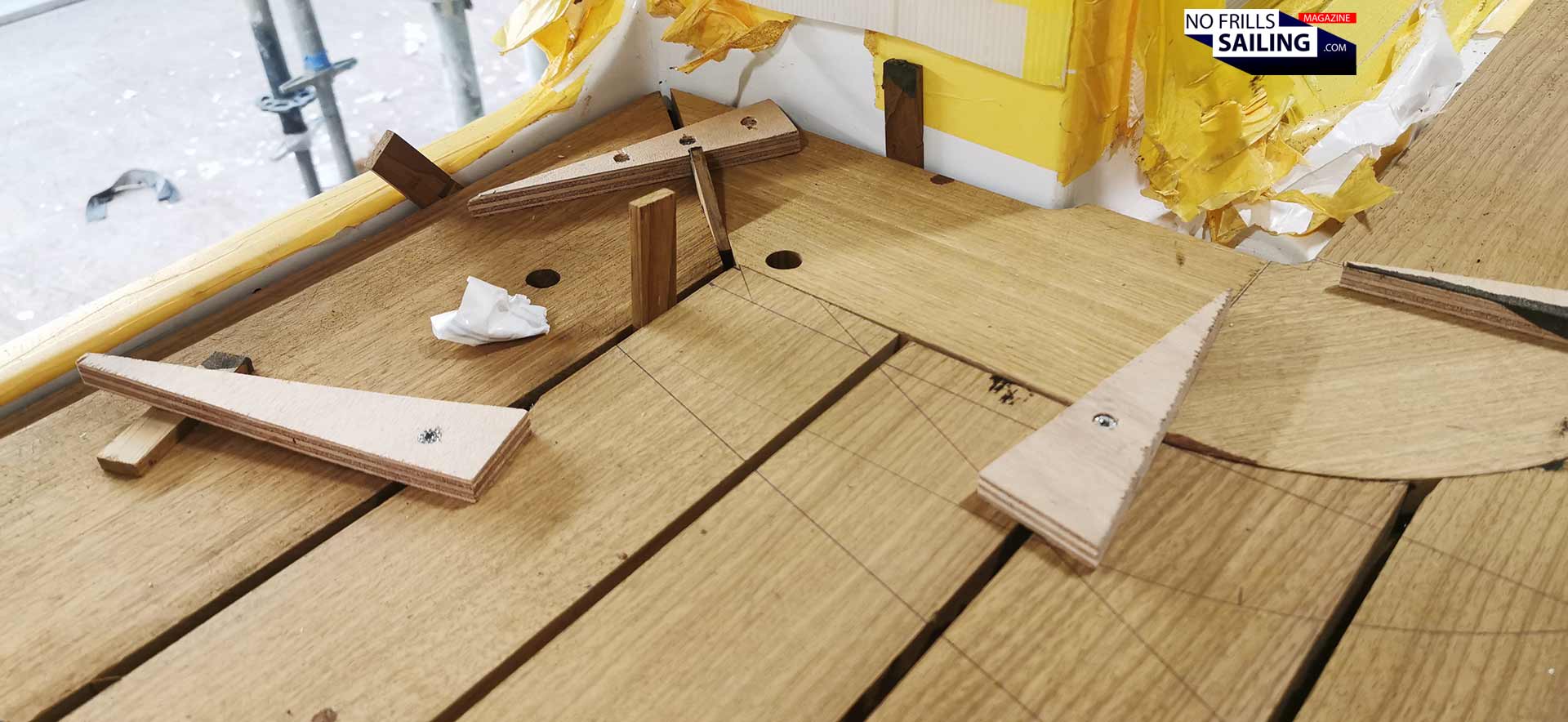
In the detail picture you can clearly see how these guys are using little plywood triangles, screwed into the base-layer of plywood to act as spacers and to fix the Tesumo-parts. Also, it appears that the outer wooden planks will be screwed in addition to being glued with Tesumo-plugs filling the boreholes. It all takes so much time and elaborate work, attention to detail and absolute discipline, I can imagine. No margin for fluctuations, let alone, errors.

Another detail is the material choice for the parts used to make the coamings. Look at the picture above where we can see a finished, already caulked part around a door. The grain of the wooden parts used here is chosen in such a way that it kind of supports the shape of the rounded corner. I mean: This is how you do it, right? I cannot take my eyes off of this, because it´s something you rarely see in “normal” boatbuilding.
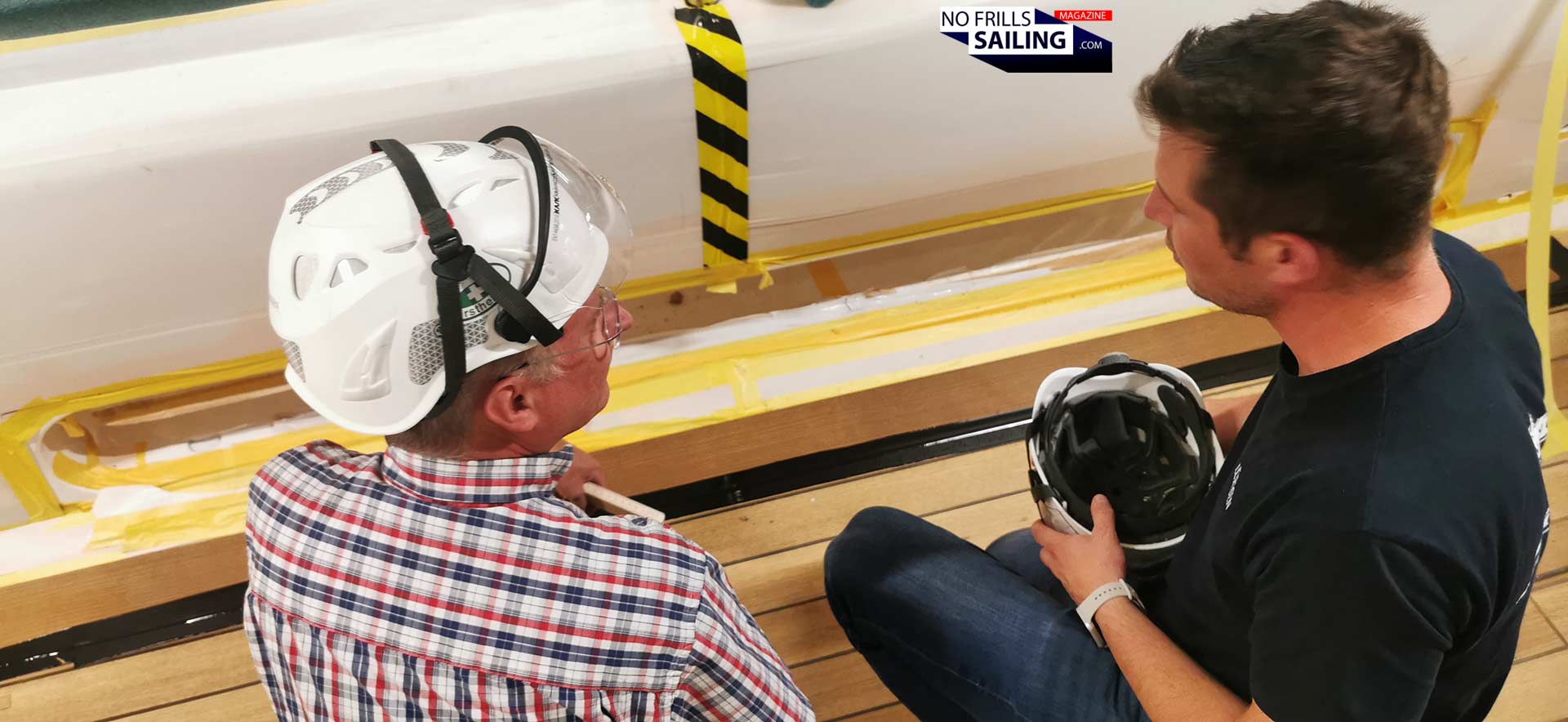
Time and again our guide is kneeling down to talk with the project manager. I don´t listen too closely, but of course they are referring to the timeline for the deck to be finished in relation to the overall building process of the ship: Co-ordinating the build of such a yacht with all the different crafts, their people and material arriving, timed meticulously in a way that things are finished before other things can happen … must be a colossal logistical undertaking! Every little delay can potentially slow down the next step, passed through the whole project, summing up in the end. No way this can ever happen!
Before installation: Lürssen´s joinery
In order to minimize delays or any surprises on the ship itself, Lürssen has implemented a lot of preliminary procedures and quality checks to make sure that up on deck only material arrives that is “ripe” and right to being worked with. We leave the awesome super-yacht and head for the shipyard´s joinery. I would have loved to get a full tour on this ship, but for obvious reasons this wasn´t possible. Anyway: Even the very limited access I got and the extremely limited view they have granted me … roaming the deck of this Lürssen yacht was the most impressive thing I´ve done in years!
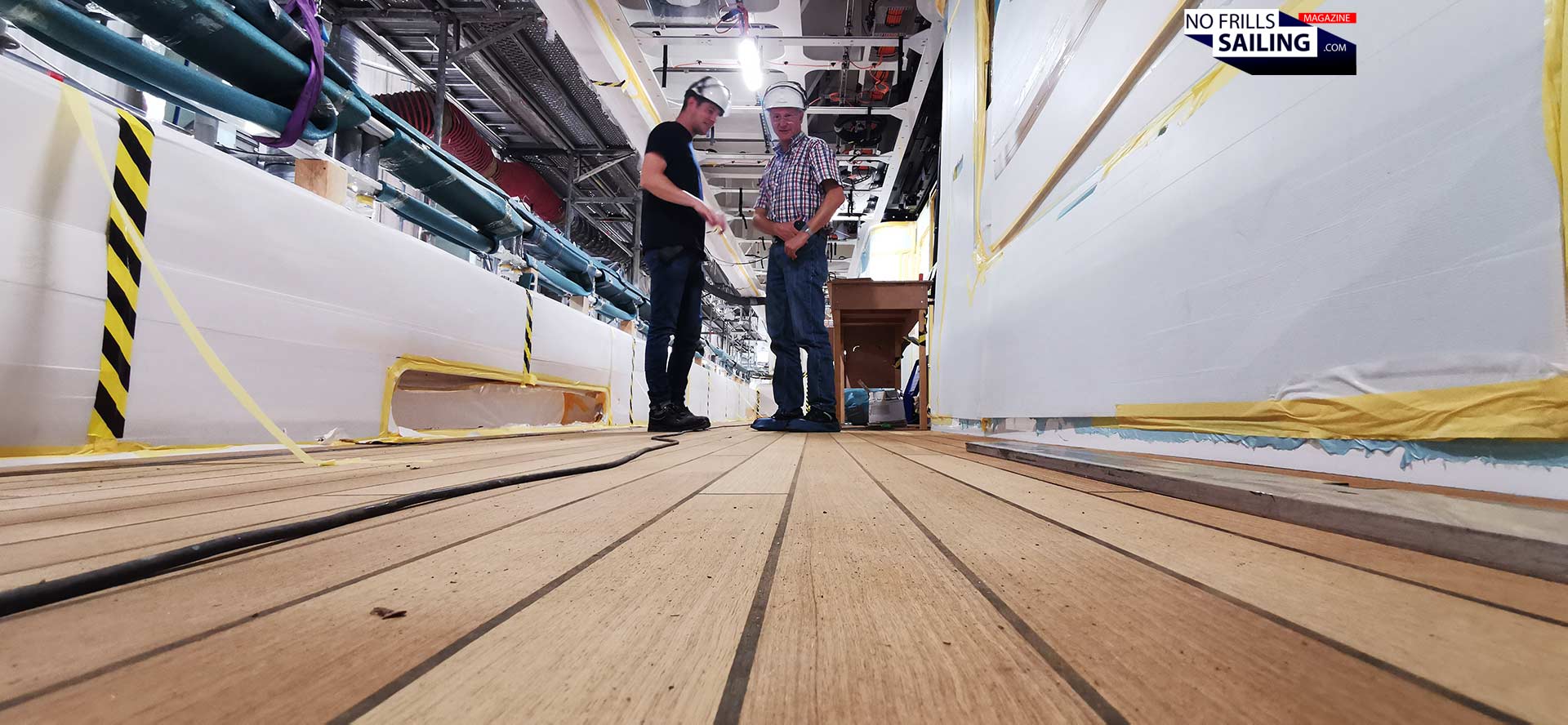
I say goodbye and thank the craftsmen aboard the ship. We again climb down the seemingly endless labyrinth of ladders, leading us back to ground level of the shipbuilding hall. As we walk by, I ask if a picture would be possible, juts to convey the sheer impressive size of this ship. The guys smile, but shake their head. Believe me: It´s a staggering view I won´t ever forget. I am not so much into power boats, let alone mega-yachts, but shipbuilding at this level is absolutely impressive. Stepping out into the glaring light of the summer´s sun, we walk between the halls. Finally, near the river, we enter the joinery of Lürssen.
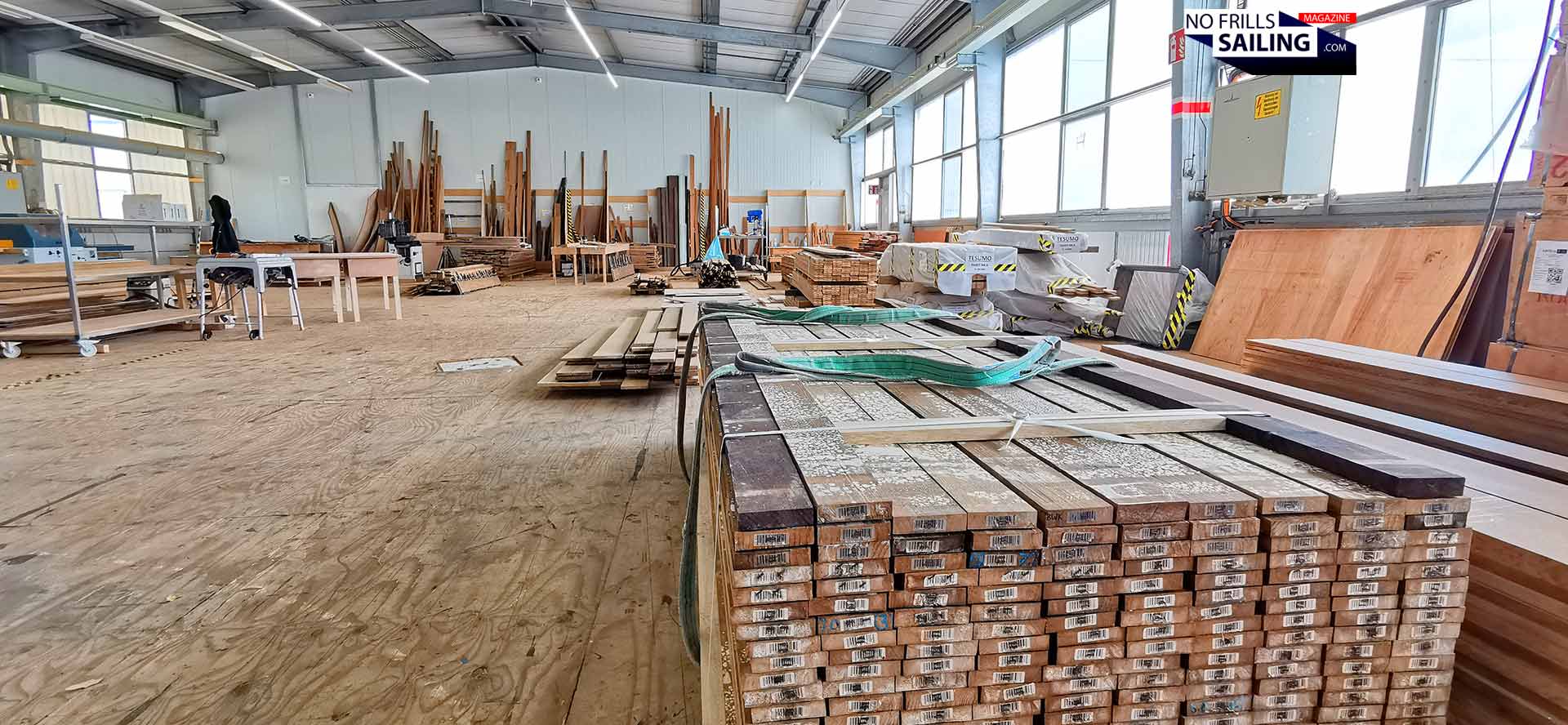
When you´ve read the first article on Tesumo-production, you have learned that the producer itself has a very strict regiment of quality management. With a still relatively high scrap rate starting at the raw Limba delivered, Tesumo produces 3 qualities of their end-product. Tier 2 and 3 are utilized in home improvement, facades or for pontoons, only Tier 1 quality is accepted to be shipped to Tesumo´s clients, just as Lürssen or Vitters. Frank shows me one of these shipments – processed Tesumo as it arrives at the shipyard.
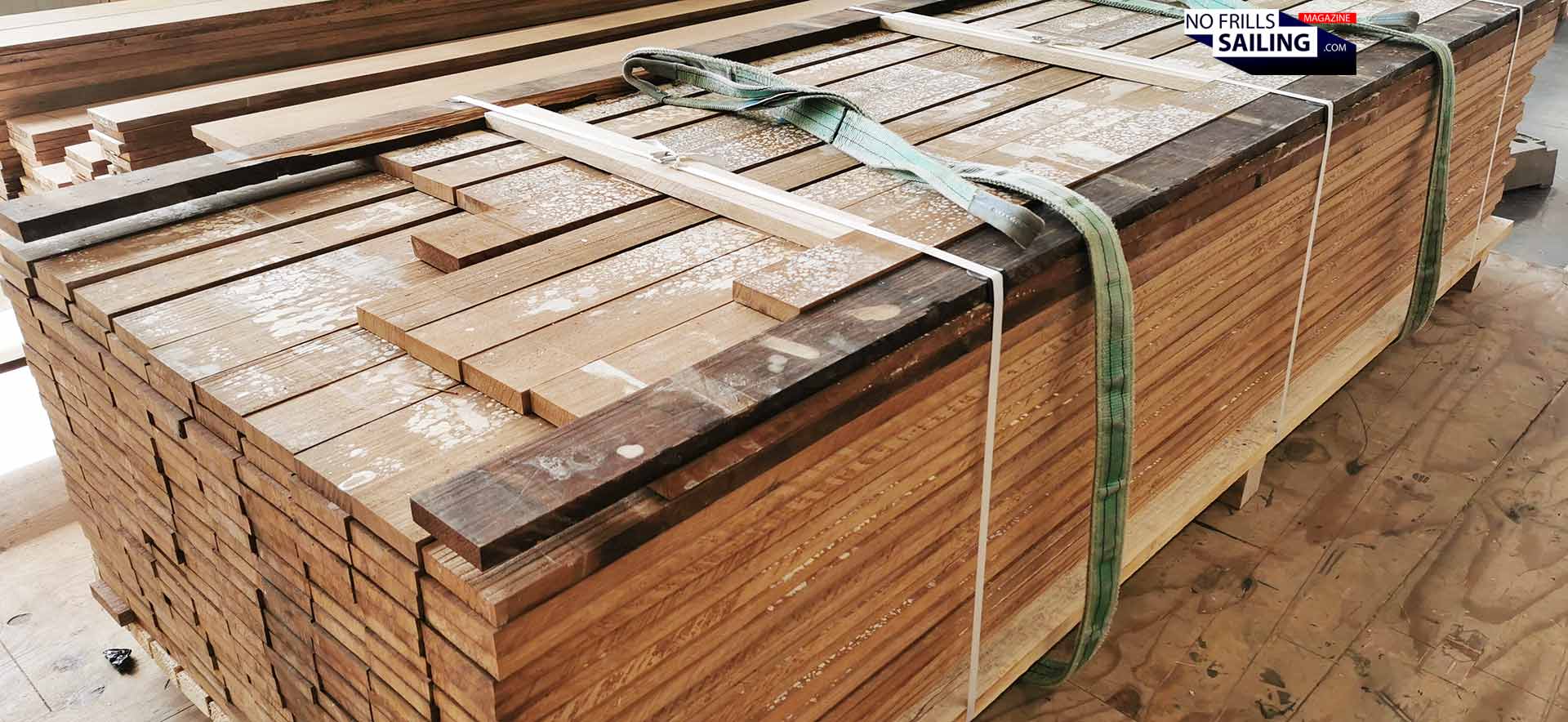
Even if this batch of raw planks has already passed the hard quality checks of the production plant of Tesumo, upon arrival, each single plank will undergo another scrutinizing quality check by Lürssen´s own joiners as they will look for left over growth defects, irregularities in the grain, production variations or other marks which deem a plank not suitable for their super-yachts.
The strictest quality policies
With just a very few ships delivered per year, Lürssen´s turnover is staggering, making it the biggest and most successful mega-yacht brand in the world. That said, budgets for one ship can reach several hundreds of million Euros. Customers ready to up that much money won´t accept anything less than sheer perfectness, Frank says : It´s a pity that even with that perfection, still so many clients insist of receiving Teak. The hope is that over time and more and more boats equipped with Tesumo, people will finally understand that there is no need to choose Teak anymore. But back to Tesumo …

With production and quality up and running, all try to minimize offcut or scrap. For example, there are areas of the ship the owners and VIP-guests may very seldom or even never see. Here, planks with minor irregularities can be used. Another possibility for planks with “marks”, would be to check the underside, to cut them up (to be used as coamings for example) or just send them back to the plant. Frank shows me some examples for such “defects” – and to be honest, I wouldn´t have seen this as a “problem” at all! But that´s the exclusivity and top-notch quality which sets apart a Lürssen from … well, “our” boats, I guess.

The raw Tesumo is planed as a first step of pre-processing here in the joinery. Put together in batches with the same length , the planks are stored until needed on the ship. For large units like the one I saw (I am not allowed to even communicate the length of this ship) planks of 21 Millimeters thickness are utilized. Apart from the fact that at Lürssen only this material thickness is utilized, Tesumo is also available in planks as thin as 9 Millimeters, but shouldn´t be sanded down to less than 8. And this is – as I see it – one of the biggest challenges for this awesome product still to overcome.
Why “standing” grain?
Lürssen, Vitters and Co might be great customers and surely, having your product accepted by shipyards like these is like an accolade. But the real deal would be the opening of the series production boat market, I am sure. Companies like the Beneteau Group with all their brands, Hanse, Bavaria and even the top-brands like Oyster Yachts or Contest would be perfect customers. But that´s the problem: 9 Millimeters (of Tesumo would be too thick or heavy. Maybe on the large +60 feet flagships it´s possible, but not on the hundreds of units below that size. Well, not now …

I guess that is something the R&D department of Bernhard is still researching on? He points to a storage of ready-to-install Tesumo planks. The numbers indicate the length of them, in this case ranging from 3 to 3.3 meters. “That´s another hurdle we have to overcome”, Bernhard tells me: “Tesumo has less elasticity than natural Teak. This means, its capability of being bent to follow sheerlines and curves is limited.” Finding a good balance between the plank´s thickness (to prevent it from crumbling) and it´s sleekness to achieve a certain curve is paramount. He points to the cross-sections of the planks.
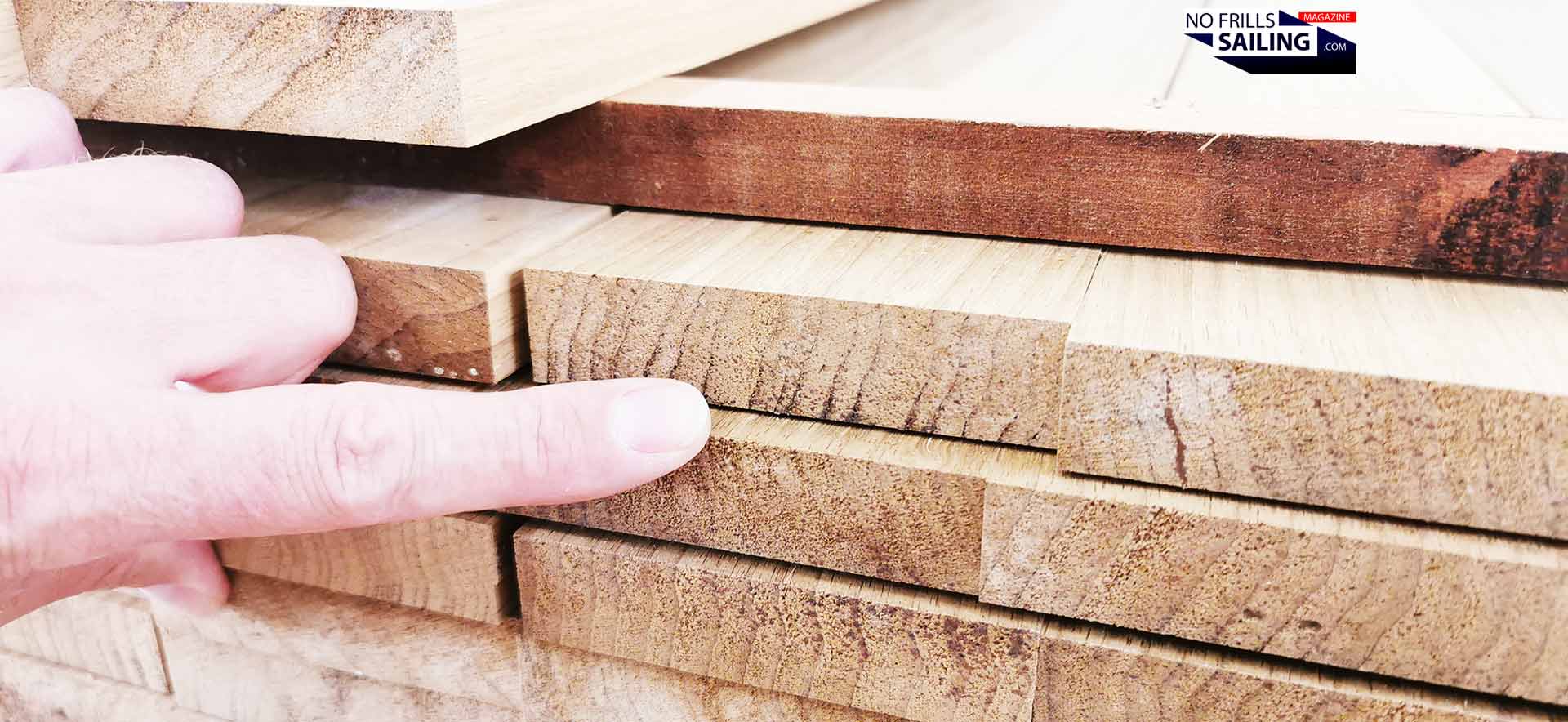
When checking for a nice grain, the quality managers don´t only look at the topside – the one, that will be facing towards people when roaming the deck of the ship. The cross section must also be scrutinized. Because the way the grain runs through the whole plank reveals how it will behave later. “We only want angles of maximum 45 degrees. Best would be would if we´d have an upright “standing” grain”, he tells me. Why? “Because even Tesumo is treated and processed, it´s still timber. Hence it´s still a natural material. It will expand in wet conditions and contract when dried.” To limit movement of the deck, standing grain is paramount as it will move only half as much as flat grain

So imagine a whole log of timber: How much brainwork and effort must be invested in cutting out the raw planks alone to achieve battens with standing grain solely?!? Imagine the amount of awareness and work Tesumo needs to invest here, at the very first stage of the long way of Limba becoming Tesumo, just to train and educate the people in the saw-mill?! In the end, knowing all of this, I can only begin to fathom the labor that´s inside every single one of those logs.
Would you be able to tell them apart?
It´s funny, I tell Bernhard: Talking to one of the craftsmen back on deck in the shipbuilding hall, I had asked him the question if there is any difference between Teak and Tesumo regarding his work. After a few thoughts he told me that of course the material feels and behaves a bit different when cut, sawed or sanded. “But you know what? When we come here in the morning to start our shifts, even we cannot tell visually Tesumo apart from Teak! No chance. It looks the same, it feels the same when walked upon.” Bernhard smiles, when I tell him this little story – and leads me to a shelf:
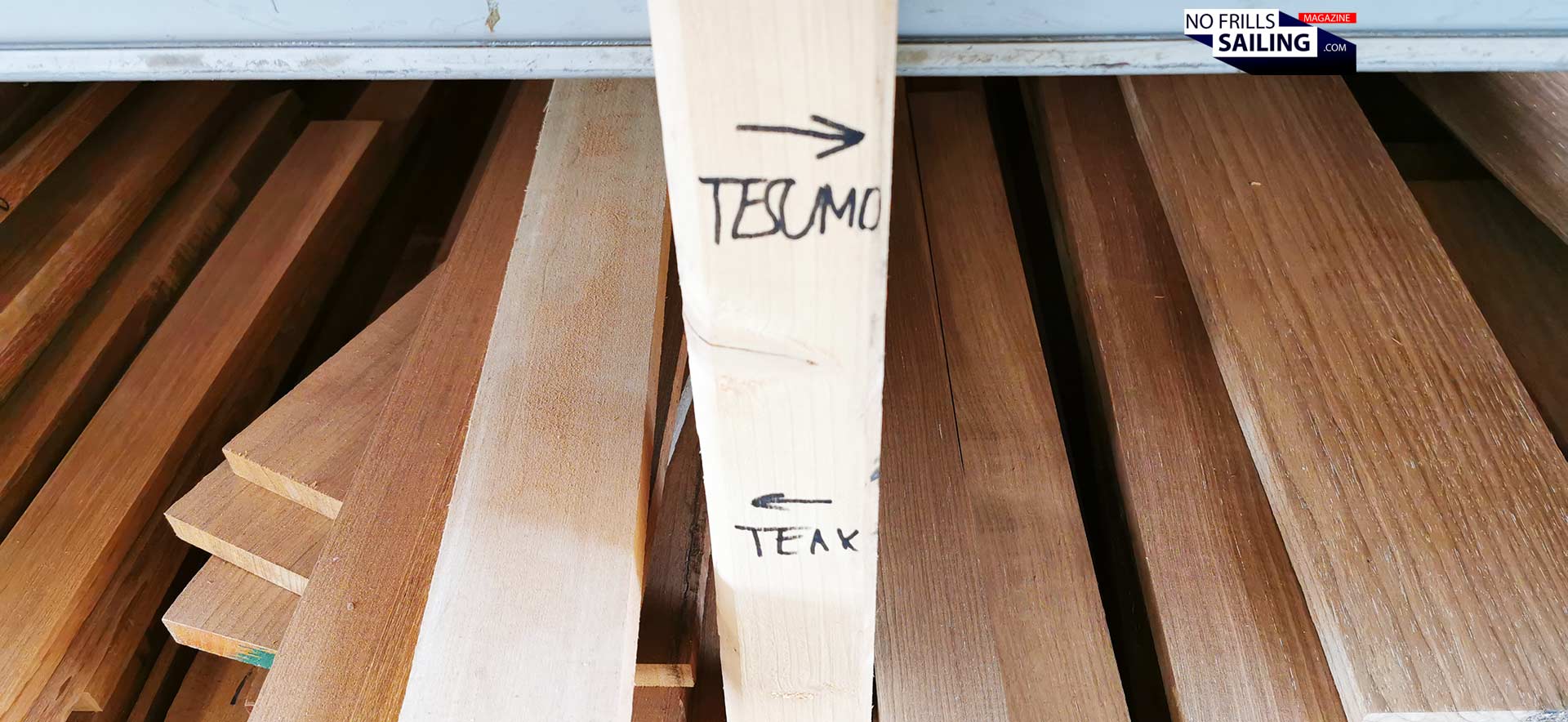
Of course, or maybe: regrettably, many customers still insist on having Teak on their yachts. So Lürssen tries to source Tier 1 legal cut Teak. That is why there´s always a huge amount of Teak timber (and many other types of wood) stored in the joinery. The shelf he shows me has a little handwritten sign: “Tesumo: right. Teak: left” it says. “Can you see a difference?” Nope. I can´t. Test passed.
What a fantastic day!
After almost a full day of roaming Lürssen, it´s time to say goodbye again. We shake hands and I thank Bernhard for the great insights he and Frank offered me in the interview (check it out here, definitely worth reading) and the exclusive tour of the Tesumo-fitted mega-yacht which will see the water still this year. It kind of makes me proud to see that “we” Germans have a shipyard like Lürssen, capable of creating such incredible machines! I would have loved to stay a bit longer and see the metal workshops where the ship´s sections are made and even the huge floating docks. But, you guessed it: Security and press restrictions. Everything is bigger here at Lürssen, I think and smile, even the Sikaflex store …

Having seen the production of Tesumo now and having witnessed the way Tesumo is fitted to a ship, the last open questions I have are: Where is Limba sourced from and what happens before the raw material arrives at the plant? And lastly: Who does a Tesumo-fitted yacht look like after a few seasons out on the ocean, being subject to the harsh elements? I hope to be able to deliver follow-up articles on those too in the near future.
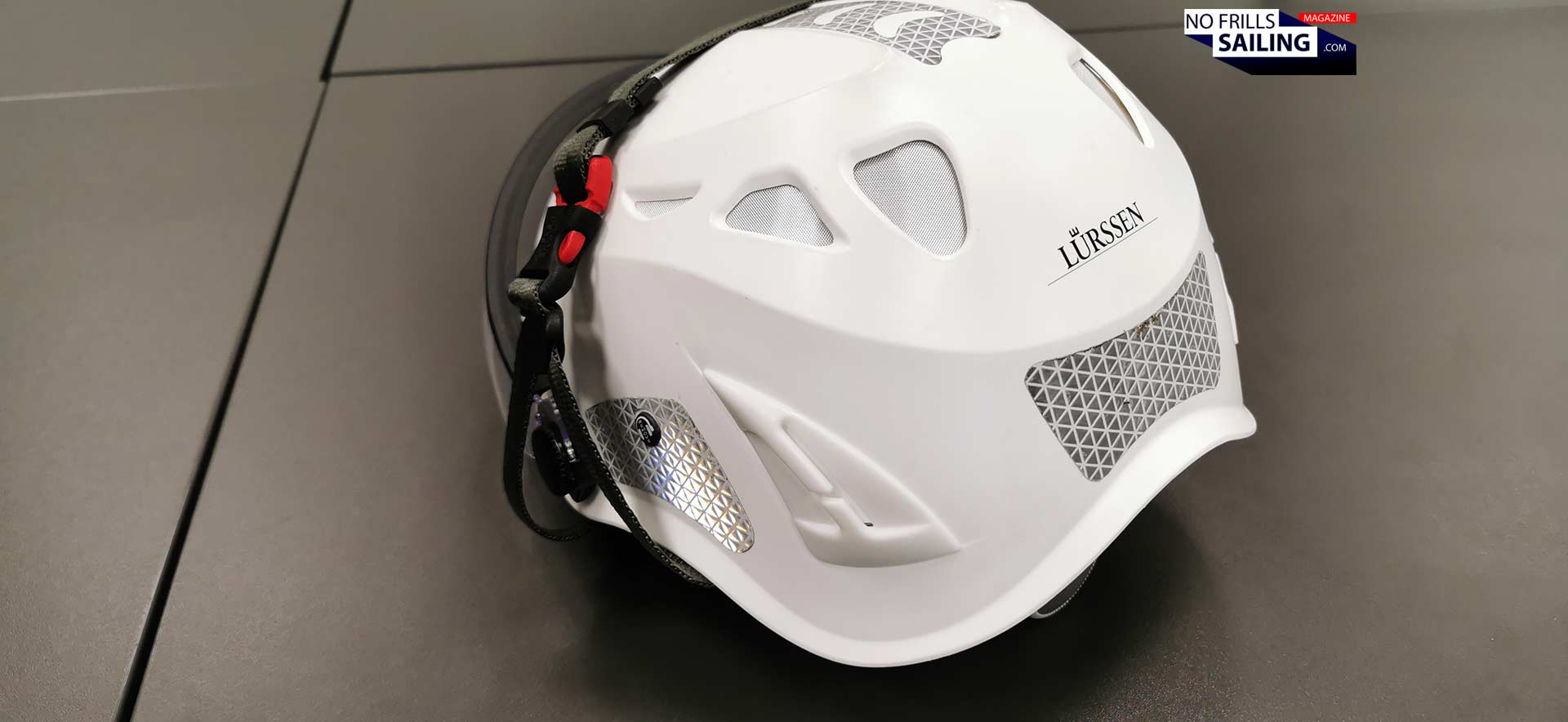
On my drive back home I process what I´ve seen and what I´ve learned. The days of natural Teak, for ecological, social, political and many other reasons, may be numbered. At least when it comes to the vast quantities needed to fit every ship and boat. It is quite fascinating to see that not only alternative materials, like Cork or Iroko are coming up, but how high-tech, lots of brains and tests can turn relatively low-grade timber like Limba into something beautiful and precious as Tesumo. A product that is of such a quality, that even the world´s leading mega-yacht shipyard accepts it for their creations.
Related articles you also might find interesting:
How is Tesumo, the natural Teak-surrogate, made?
Inventing wood: Talking to the fathers of Tesumo
All articles on the #woodenfuture of boatbuilding
